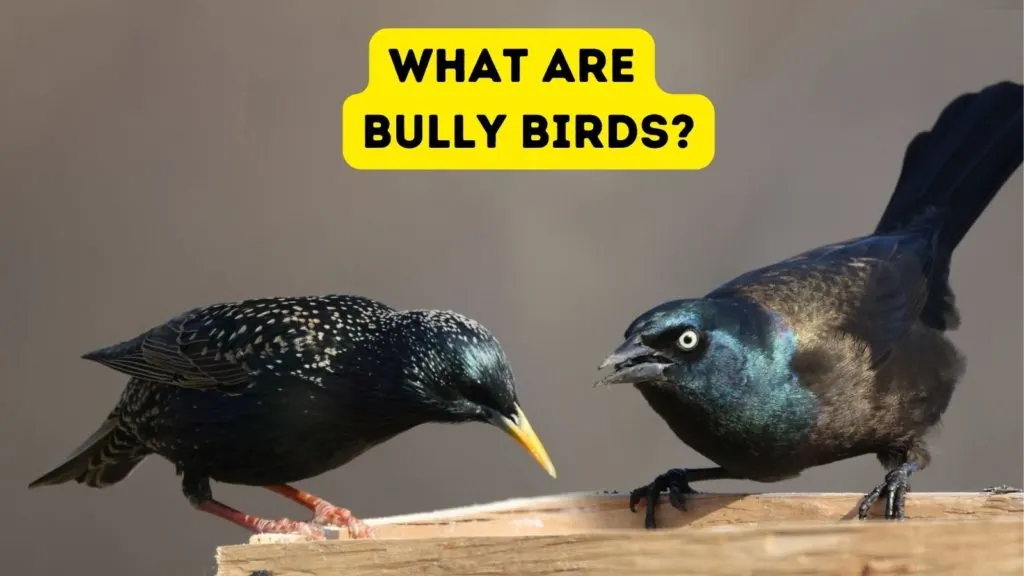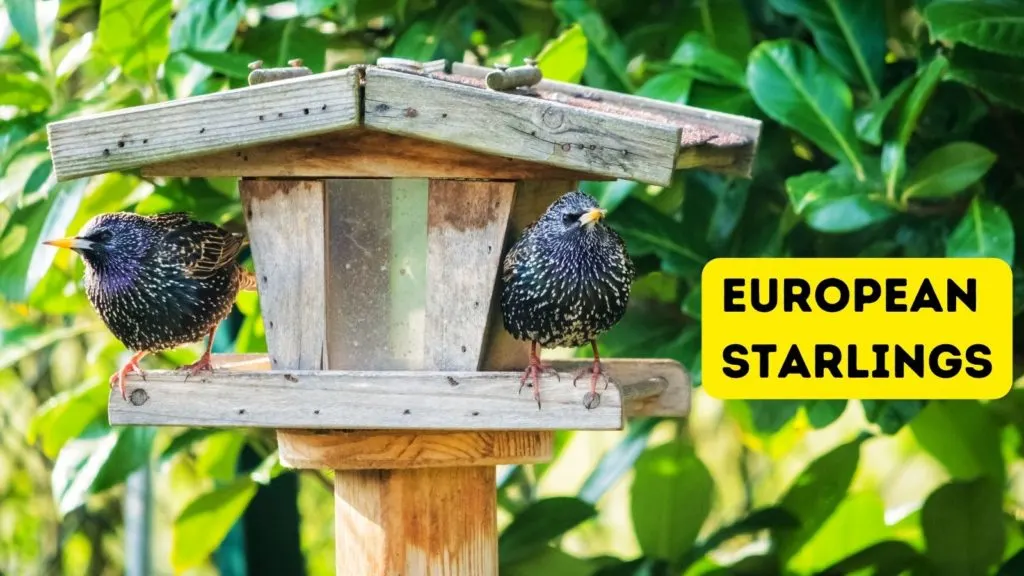In birding books, you might run across the term “bully birds” to refer to species that dominate feeders or birdhouses, often at the expense of smaller, more timid birds. These birds are typically larger, more aggressive, and consume a disproportionate amount of food, making it challenging for a diverse array of bird species to thrive in one area. Let’s look at the birds that may act as bully birders around your feeder and ways you can help keep everyone happy and fed.

Which Birds Are Considered Bully Birds in the US?
Several species are commonly identified as bully birds across the United States. These include:
European Starlings: Not native to the U.S., these birds (above, left) are very aggressive and can form large flocks that overwhelm feeders and displace native birds. Introduced to North America in the late 19th century, these birds have become one of the most abundant and adaptable bird species across the continent. Their aggressive behavior at feeders and nesting sites, coupled with their large numbers, allows them to dominate over native bird species, making them unwelcome guests for many bird lovers.
Common Grackles: Grackles (above, right) travel in large groups and are known for their iridescent black feathers. They can dominate feeders quickly due to their size and social nature. (Personally, I love grackles and their amazing sound. They’re intelligent birds but I do agree that they can take over a feeder.)
House Sparrows: Another non-native species, House Sparrows are aggressive towards smaller birds, especially when it comes to nesting sites, often evicting other birds from their nests. Although these birds are small, their numbers make up for their size!
Brown-headed Cowbirds: Although not generally a problem at feeders, Cowbirds are a serious issue for nesting birds. Known for their brood parasitism, they lay eggs in the nests of other smaller bird species, which can lead to the decline of those populations.
Why Are They a Problem?
Bully birds pose several problems for backyard bird enthusiasts and the broader ecosystem. It’s not just a matter of “wasting” bird seed at your feeders that’s only enjoyed by these species that monopolize food sources (as well as nesting sites).
These birds can also contribute to the decline of native bird populations through direct aggression or competition for resources. Their behavior can discourage the presence of more desirable and colorful bird species, reducing biodiversity in backyard habitats.
The Problem of Starlings

For many backyard birders, Starlings are the number one bully bird. The issues caused by European Starlings extend beyond backyard bird feeders. They can have significant negative impacts on agriculture, by consuming and contaminating livestock feed and damaging crops. Their large flocks also pose serious risks to air traffic and have been implicated in bird strike-related accidents.
Around the feeder, they’re considered bullies for numerous reasons:
- Aggressiveness: Starlings can be very aggressive towards other birds, especially when it comes to competing for food and nesting sites.
- Large Flocks: They often travel in large flocks, which can overwhelm feeders, monopolizing food resources and leaving little behind for smaller, native birds.
- Nesting Sites: Starlings are known to take over the nesting sites of native cavity-nesting birds such as bluebirds and woodpeckers, often evicting them and taking over their nests.
- Adaptability: Their adaptability to various environments and food sources means they can thrive in a wide range of habitats, often to the detriment of native species.
How to Protect the Bird Feeder from Bully Birds
Managing bully birds involves a combination of deterrent strategies and fostering a more inclusive environment for all bird species. Here are some effective solutions:
Use Smaller Feeders: Smaller feeders that only accommodate smaller birds can deter larger bully birds, who find it difficult to perch or access the food.
Selective Food Choices: Bully birds are less attracted to certain types of seeds, such as safflower seeds, which are not their preferred food. Nyjer (thistle) seeds are excellent for finches and other small birds but are typically ignored by bully birds.
Caged Feeders: These feeders have a protective cage around them, allowing only small birds to enter and access the food.
Avoid Ground Feeding: Bully birds are often ground feeders, so avoiding or minimizing food dropped on the ground can reduce their presence.
Regularly Change Feeding Locations: Moving feeders around can confuse bully birds and make it harder for them to dominate a single area.
Provide Natural Cover: Planting bushes and trees can offer natural protection and nesting sites for smaller birds, making your backyard more inviting to a diverse group of species.
Implementing these strategies can help ensure that your backyard remains a haven for a variety of bird species, not just the dominant few. It encourages biodiversity and provides a more balanced ecosystem for all birds to thrive. While it might not eliminate bully birds entirely, it can significantly reduce their impact, making birdwatching and feeding a more enjoyable and rewarding hobby.
How to Protect Bird Nests
Protecting bird nests from bully birds, such as European Starlings, House Sparrows, and sometimes larger aggressive birds like crows and certain jays, requires a multifaceted approach. These species can pose a significant threat to native birds by taking over nesting sites, destroying eggs, or harming chicks.
Here are several strategies birders can use to help protect bird nests from these aggressive invaders:
1. Use Predator Guards
Installing predator guards on birdhouses can help deter bully birds and other predators. These can include entry hole guards that restrict the size of the bird that can enter the nest box. This helps protect smaller native bird species.
2. Monitor and Maintain Nest Boxes
Regularly monitoring nest boxes for signs of invasion or harassment by bully birds is crucial. Keeping nest boxes clean and in good repair can also help.
If you notice a bully bird trying to take over a nest box, you might need to temporarily block the entrance (when birds are not actively using it) to discourage the unwanted visitor.
3. Choose the Right Location
Place birdhouses and nesting sites away from areas that are attractive to bully birds. For example, avoid placing them near open garbage or food sources that might attract these species. Instead, place birdhouses in quieter, more secluded areas of your yard.
4. Install Decoys or Use Visual Deterrents
Sometimes, visual deterrents like decoy predator birds (owls, hawks) or reflective objects can help scare away bully birds.
However, these methods may require periodic movement or changes to remain effective, as birds can become accustomed to them over time. Birds can soon learn that the “owl” never moves!
5. Encourage Natural Predators
Creating a habitat that is friendly to natural predators of bully birds, such as hawks or owls, can help control their population. This might include maintaining large trees that are attractive as nesting sites for these predators or installing owl boxes.
6. Create a Diverse Habitat
Designing a garden that attracts a wide variety of bird species can also create a natural balance and discourage the dominance of any one species. Planting native plants, shrubs, and trees provides natural nesting sites and food sources that can support a diverse bird population.
7. Educate Your Community
Sharing knowledge and strategies with neighbors and local birding groups can amplify your efforts. A community approach to creating bird-friendly environments and managing bully birds can be more effective than individual efforts.
Protecting bird nests requires patience, persistence, and a willingness to adapt strategies as needed. By taking steps to deter bully birds and create a safer environment, birders can help ensure that native species thrive in their backyards and local communities.
- 8 Letter Bird Names - August 14, 2024
- 7 Letter Bird Names - August 14, 2024
- 7 Birds Named After Famous People - July 23, 2024
